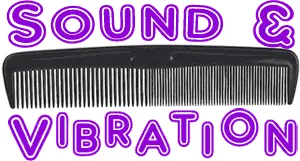 The Teacher's Corner
The Teacher's Corner
Puzzles and Activities
Hello from Sunny Boca Raton, Florida. We are still here, doing shows for Florida Power and Light. This weekend I rewound the secondary coil of my big Tesla coil, took Lisa shopping, set up a new operating system on my computer, and slept a lot to rest up for the coming week of shows.
I also had a chance to talk with my good friend Mik Jacobs. He is now set up in Florida, doing science theater development and fire safety shows. We were swapping science ideas and he asked if I had ever done an experiment with a comb kazoo. That led to an interesting discussion and this week's experiment.
 To try this classic experiment in sounds, you will need:
To try this classic experiment in sounds, you will need:
All right, I admit that I have never been very musical. About the only musical instrument that I play well is the radio. Still, with this week's experiment, even I can make music, or at least something close enough to cause Lisa to ask me what that noise is.
Cut a piece of waxed paper that is as long as your comb and wide enough so that if you fold it in half, it will cover the comb. Hold the comb with the teeth pointing downwards. Fold the waxed paper in half and place it over the comb. Hold the paper lightly against the comb. Place the paper and comb lightly against your lips and say "Oooooooooo".
You may have to try several times, but when you get it right you will know. The waxed paper will vibrate, making a buzzing sound with a pitch similar to the sound you are making. The vibration will also cause a tingling sensation on your lip.
Once you get the hang of it, it is really very easy. The best part is that you can now play any song that you can hum. You don't even have to know the words. This is a version of a musical instrument called a kazoo.
OK, so we have a fun thing to play with, which also has the added benefit of making lots of noise to annoy big brothers, etc. But where is the science?
Actually, this is a very nice way to explore the basics of sound. In studying sound, we study vibration. Anything that is making a sound is vibrating. Is your kazoo vibrating? Yes! That is what makes your lip tingle.
What causes the kazoo to vibrate? Place the back of your hand gently against your lips and hum the same way you did for the kazoo. Again, you feel vibrations. Where are those vibrations coming from? Put your fingers lightly on your throat and hum again. Ah! The vibrations are coming from your vocal cords in your throat. Air from your lungs moving across the tight vocal cords causes them to vibrate. That causes the air in your throat and mouth to vibrate. The vibrations are transferred from the vibrating air to the paper of the kazoo.
The vibrating paper then causes the air around it to vibrate. Because the paper is flexible and loose, it distorts the vibrations, giving the kazoo its interesting sound. The vibrations spread through the air just as waves spread across the surface of a pond. When the vibrations reach your ears, they cause your ear drum to vibrate, just as the vibrating air from your mouth caused the waxed paper to vibrate. Your ear drum passes the vibrations along through a series of tiny bones (The hammer, anvil and stirrup are the smallest bones in your body.) and then to your inner ear. This is a snail-shell shaped structure filled with liquid. When the liquid vibrates, it moves nerves which send a message to your brain which you interpret as the sound. The vibrations are transferred from object to object, vocal cords to air to paper to air to ear drum to the series of tiny bones to inner ear.
And now for the answer to all of those out there that know how "hair challenged" I am. I did not have a comb, since I usually don't have much use for one. Lisa gave me one for the experiment, and of course I promised that I would never part with it. (grin)
 Check out more Experiments for Kids
Check out more Experiments for Kids
All lessons are brought to you by The Teacher's Corner and Robert Krampf's Science Education Company.
Robert Krampf's Science Shows thehappyscientist.com